
When I was in high school I pined for a partner who played guitar. How cool. How talented. How lovely to sit and listen to the beautiful melodies floating through the air.
After a while I came to realize that it was silly to look for something in a partner rather than build that skill in myself. I didn’t want to have to depend on anyone else to make me happy, I wanted to be able to do that myself. So I started to fool around with learning some chords.
It wasn’t until I was in university that I actually got serious about my newfound instrumental love. I picked up a cheap guitar from a music store and have been steadily learning more and more about how to make music happen by picking and strumming. I’m so happy I did, because I have spent hours upon hours soothing my soul by pouring my heart into the music that comes out of my guitar, and the lyrics that flow out of my lungs. It is so much better to make music yourself than it is to always just listen to someone else.
I never took a class, and – although I’m sure I’d find one very useful – it wasn’t necessary. With the help of books, YouTube and the internet, you can pretty much learn how to do anything by yourself. Except maybe surgery. I’d leave that to the professionals, unlike this crazy Facebook group (warning: gruesome stuff there).
So, how can you teach yourself to go from nada to sing-song leader and star performer? Okay, maybe I still haven’t got up on stage (I got really close one time… but it ended up not being open mic night… phewph!), but I feel pretty confident that I do a decent job of campfire sing-a-longs and one day I WILL make it up on a stage for open mic night. One day…. But for now I want to share some tips that might help you on your way to learning how to play a guitar yourself.
*Note: I am talking about learning to play acoustic guitar, but all of these points could just as easily apply to ukulele, another fine, stringed instrument. The uke is actually a much easier instrument to play as it is tuned to a different scale that makes it always sound good, even if you’re playing it wrong. Four strings is also a lot easier to work with than six, which makes it a great starter instrument for children.*
5 Steps to Teaching Yourself to Play Guitar
1. Get yourself a guitar. If you seriously want to learn, you’ll need an instrument to play. Don’t think you’ll be able to learn by popping in at your friend’s house to borrow their guitar. You will need your own for the convenience of seeing it in your house and having it there to pick up whenever you have some time. You can pick a simple one up from a store that sells instruments for around $100. The investment will be absolutely worth it if you actually put the effort into learning a couple things.
Guitar’s with a nice wide neck and nylon strings are easiest for me to play on, which seems to be characteristic of “classical” acoustic guitars. Mine has a completely different sound than my husband’s guitar, which has a skinnier neck (harder to find the right spots for fingers) and all metal strings.
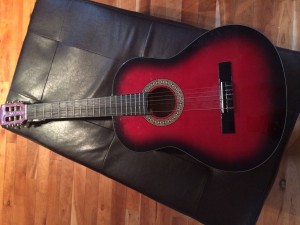
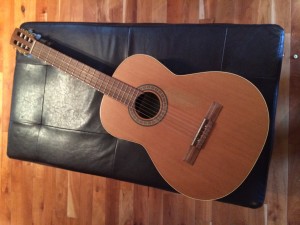
2. You will absolutely need a tuner. You can easily learn how to tune a guitar to itself, but when you’re just learning, you’ll want to make sure everything sounds as it should without a lot of guess work. I recommend a tuner that clips onto your guitar and shows you very clearly if the pitch is too high, too low, or just right, with a sequence of dots that light up.
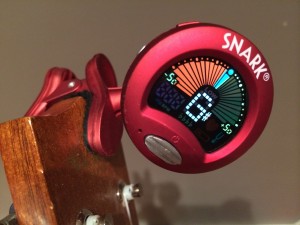
3. When you’re first learning, choose a song or two that you know really well. You know the beat, you can hear in your head what all the instruments in the original are doing, you know the lyrics and the pauses… You could sing the song without any cues. If you try to learn a song you like, but aren’t really familiar with, you are setting yourself up to fail. Go with what you know to start. For me, it was classics like Tom Petty’s “Free Falling” and Pink Floyd’s “Wish You Were Here” that got me started.
4. Go to ultimate-guitar.com and sign yourself up for a free account. This is hand-down the best tablature and chord music site I’ve found, and I have been using it for years. You can save the songs you like or know, find chords and tabs to almost any song you can think of, you can add your own, and there are a bunch of nifty little features. Best yet, they now have an app you can download, as well, which is amazing as you can access your song bank even when you’re out of wireless reception. The app lets you automatically scroll down the song with whatever speed you like so you can play without having to worry about moving the page. There are a lot of other great features with the app, too, that you’ll just have to check out for yourself.
Also, make use of YouTube. You can find detailed instructions within videos for how to make a song sound just right with strumming patterns, little riffs of picking, and other details that are hard to figure out just by looking at a tab. If you’re trying to learn ukulele, I strongly suggest checking out Ukulele Mike on Youtube.
5. Make yourself a music book. Sure, there are a lot of awesome books you can buy with different bands and genres of music already there for you to play from, but having your own binder full of songs that you love and know, in the chords and styles that you like and can play, has been the best way for me to build my collection of songs. Whenever I learn a new song, I copy the lyrics and chords/tab from ultimate-guitar.com (or wherever I’ve found the one I like) and paste it into a word program. From there I do a run through with my guitar to make sure all the chords are lined up where they should be with the lyrics and it all looks good, then I print it and slip it into a clear sheet protector and add it (in alphabetical order, for me) to my book. When I sit down to play, I have all the songs I know there waiting for me (instead of trying to remember what I know and how to play it), and can flip through for ages playing whatever calls out to me at the time. It’s also great to bring along to a campfire or wherever you’ll be bringing your guitar, so others can read along with the lyrics and sing or join in with their own instruments. Make sure you print off a comprehensive chord chart, too, and put that in the front of your binder so you can quickly flip to it whenever you come across a chord in a song that you can’t remember how to play.
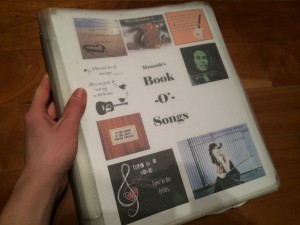
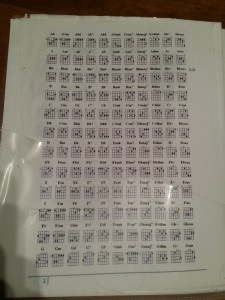
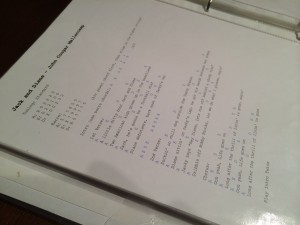
I hope I’ve helped you on your way to becoming the musician you’ve always dreamed of being. If you’ve found my tips useful, please let me know by commenting below, and don’t forget to share this post with others, using the little clicky buttons below, so they can get on their way to musical bliss, too.
One thought on “How to Teach Yourself to Play Guitar”
Thanks for sharing all these tips, Hannah. I used to play lightly in late high school/university but stopped. I still have a guitar and lately have been wanting to get back into it. Seeing as there is so much online help now, I feel like it may just be doable!